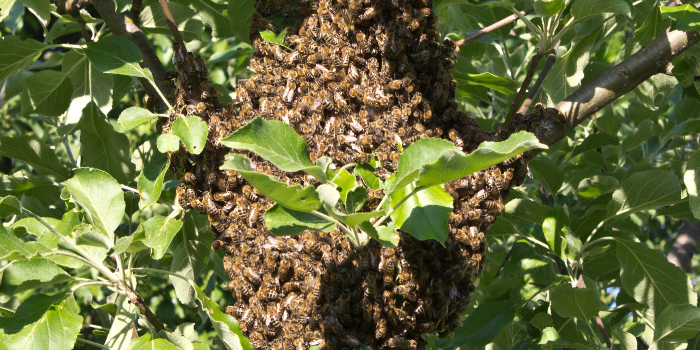
The Beekeeper's Guide to Swarm Prevention - Part 2
In our last post, we discussed swarming activities. Today, we’re going to take a closer look at this important topic.
Why is Swarming a Problem Anyway?
If you have a colony that decides to swarm and you’re unable to capture that swarm, those bees are gone forever. This may cause several problems which include:
- Loss of approximately half of your colony
- Loss of honey stores — the bees gorge on honey before leaving
- Affects future honey production — fewer bees means less honey
- If the hive does not recover, especially if it has to deal with other issues such as pests, it may have a tough time making it
The most common causes of swarming are lack of food and lack of space. Timely inspections will help you address both problems before swarming activities take place — supplemental food sources can be provided or additional brood boxes and supers can be added.
Bee Species Known to Swarm
There are several species or breeds of bees that have been domesticated, and some are more prone to swarming than others. Caucasian and Buckfast bees have the lowest inclination for swarming activities. African, Africanized and Carniolan are more prone to swarming activities. Russian, Cordovan, German and Italian species fall in the middle. Swarming activity is not the only criteria to consider when purchasing bees, however. All species have pros and cons that should be weighed before deciding which species is best for you.
Ventilation and Congestion
When a hive becomes overcrowded, two problems can occur — poor ventilation and congestion.
Congestion can best be avoided by:
- Adding honey supers before the first nectar flow in the early spring
- Anticipating the needs of your colony and providing brood chambers — giving them the room they need to expand
You can help your colony with ventilation by keeping the inner cover ventilation hole open. Additionally, you can drill holes in the upper brood chamber and in the supers.
When the weather turns hot, make sure your hive has shade — too much heat will make ventilation problems even worse. Positioned under overhanging branches is ideal. Hot weather also means that you will want to make sure your bees have a nearby source of water. Bees use water for evaporative cooling purposes inside the hive. After dispersing water droplets strategically in the hive, they fan their wings rapidly, setting up cooling air currents in the hive. These air currents maintain temperatures, keeping them ideal for developing brood. They also prevent the wax from melting.
Count Queens
During your hive inspections, you’ll want to look for supersedure cells. If you find any, you know that the colony is either attempting to replace an old and/or damaged queen, or they are preparing to swarm. If you’ve fallen behind in your hive inspections, these cells may have hatched, and you could have more than one queen. Although there are reports of more than one queen coexisting in a hive, that is the exception. When you find more than one queen in your hive, you can typically expect a swarm to take place soon. If your bees are experiencing conditions that lead to swarm activity (outlined in our previous post), it’s a good idea to count your queens. If you find more than one queen, you’ll need to do a hive split or kill all but one queen and hope the bees don’t decide to swarm anyway. Splitting the hive is best when more than one queen is found.
Additional Things to Consider
Are you prepared to take measures if your hive prepares to swarm? With all the fun we’ve been having with COVID-19, the mail system is running slower than usual. Since swarming activity begins in March, you don’t have much time to order and receive the supplies you need to capture swarms should they occur. Having swarm traps/empty hives and attractant in place and ready for use will prevent you from having to do a mad scrabble if you notice swarming activity.
Do you need to buy bees for your hives this season? Our NUCs can still be purchased at 2020 pricing.
Joins us next time when we discuss supersedure cells. Until then, grab a book such as Swarm Essentials to learn all you can about the wonderful world of beekeeping.



Leave a comment